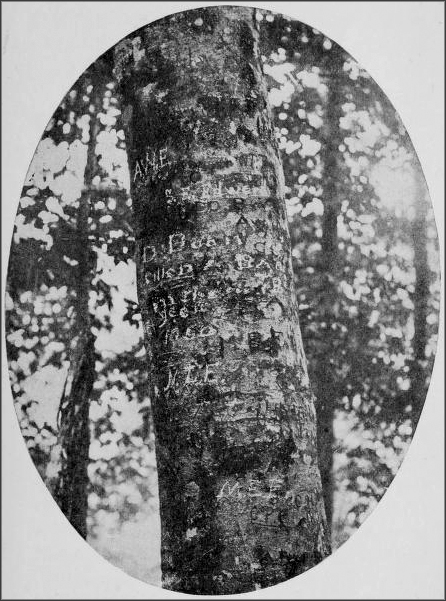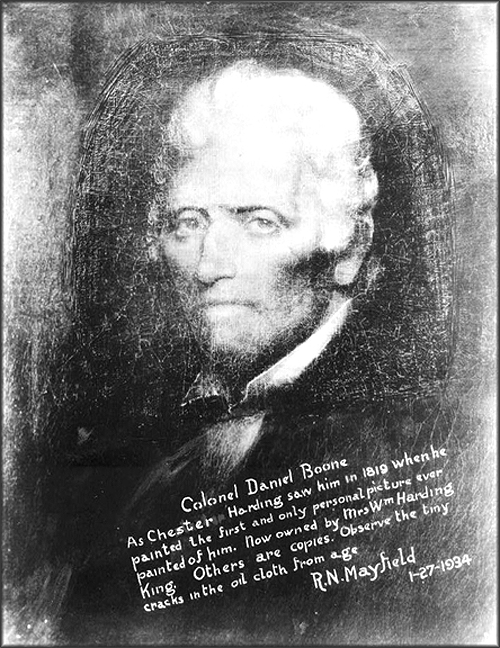Today's feature is a continuation of my mid-march Daniel Boone tree column, which contained paraphrased news briefs taken from a variety of newspapers. Today's feature is a continuation of that theme spanning 1897-16.
09-11-1897
News from Bristol, TN indicated that a farmer found an old battered brass kettle, which was removed from the ground on a farm near Bluff City. On the side of the kettle near the rim were the letters,: “D. Boon, 1760.” The kettle was allegedly used by the noted pioneer-hunter.
07-04-1901

Daniel Boone Beech Tree That Once Resided in Boones Creek with Inscription and Grafitti
The Washington County Historical Society met at the famous Boone tree for the purpose of organizing a historical society there. A platform was erected at the foot of the famous Boone tree, where Judge S.J. Kirkpatrick, president of the Society, presided. The exercises were opened with singing and prayer. After that, the chairman stated that the meeting was to organize the new society, which was to act in connection with the county society in locating and marking the site of Bean's cabin. An effort was also made to have a nice marble slab placed to mark the spot where Bean's cabin stood.
Judge Newton Hacker was introduced and delivered a speech tingling with patriotism. It was scholarly, instructive and well-received by the vast audience present. At 1:30 p.m., an old fashioned East Tennessee dinner was served on the grounds, perhaps on the very spot where Boone dined on some of his “bar” meat many years prior.
In the afternoon, there were additional speeches from historians, all of which were said to be well-timed and replete with patriotic utterances and historic information, much of which could not be found in books. All this was captured and treasured by the historical society before it was lost to the ages.
Several months before the gathering, a largo limb was blown from the Boone tree, which was promptly retrieved and made into pleasant looking pipes by the owner of the land, a Mr. Maupin. He sold about a 100 of the prized relics for 10 cents each.
The road from Jonesboro to the Boone tree was the same one that Old Hickory, Andrew Jackson, used to travel more than 60 years ago. Along the way, many of the farm houses were decorated in honor of that Thursday. One large brick house, the home of William Deakins, had streamers and national colors displayed in great profusion. The word “Liberty” in large letters was suspended between two trees.
The name of “Washington” was on the front door step. Under the mail box was a picture of the Honorable Walter P. Brownlow, surrounded by a wreath of flowers, while on the other side of the gate was a magnificent portrait of President McKinley, enclosed by a wreath comprised of the national colors.
Afterward, the meeting was dismissed and the participants went merrily on their way.
10-11-1907
In olden times, our brave pioneer ancestors wore buckskin clothes trimmed with long fringe or fur. They carried long rifles with barrels made of imported horseshoe nails, wooden stock trimmed with brass and ornamented with eagles, raccoon, deer and other objects cut from shells and set into the wood. These hearty souls also carried long hunting knives and buckskin or leather bullet pouches, often beautifully decorated with patterns of colored porcupine quills and glass beads or made of some expensive fur. Their powder was carried in cow-horn powder flasks scraped smooth with pieces of broken glass and with the surface engraved in rude designs of suns, moons, stars and figures of big game.
In their leather belt, which encircled the waists and belted in the wamus (a warm work jacket made usually in a belted cardigan style and of sturdy knitted or woven fabric), they carried trusty tomahawks. Many of the picturesque old fellows were expert in the use of little camp-axes as weapons.
Daniel Boone carried an ax of this kind and the trees he blazed with his tomahawk to mark the boundaries of land became known as “Boone trees.” In later years, lawsuits were decided by the identification of blazed boundaries that came from the unmistakable stroke of Boone's tomahawk.
06-07-1916

Portrait of Daniel Boone Taken in 1819 Just Prior to the Pioneers Passing at Age 86
Misfortune struck during a severe windstorm that visited the Boone's Creek and surrounding areas on a Saturday afternoon. The famous historical Boone Tree was blown to the ground, causing it to separate at a most unfortunate section – the part of the tree containing the famous inscription. The disheartening discovery of the fallen tree was made the following day, bringing a sizable procession of mourners to witness the unfortunate incident. Most who saw it spread the news that it needed to be immediately removed from the land and sent to some qualified society for preservation.
The John Sevier Chapter of the DAR took instant action, seeking first to purchase from Lafayette Isley, identified as the owner of the land where the tree stood, the part of the tree containing the carved words. The chapter was convinced that the section could be preserved as a historical relic. They further believed that time was of essence to accomplish this noble effort. The DAR was making plans to preserve the tree at the time the tree lost its footing. Their well-meaning campaign was not yet in place when the windstorm felled it.
06-26-1916
A few weeks later, another newspaper commented on the demise of the popular Boone tree. It noted that the site that had linked the history of 156 years ago with the present time was no more. Admittedly, the letters on the tree were dimmed with age but could still be identified. The DAR acquired the lettered section and had it sent off for preservation. My information does not reveal what happened to the relic. The tree had stood as proof that Boone penetrated through the eastern chain of mountains from his log cabin on the Yadkin River in North Carolina in 1760, although contemporaneous historians place his entrance into the wilderness, as the western country was then called, several years later.
Historian J.G.M. Ramsey, who wrote “The Annals of Tennessee,” published in 1853, was the first to document the inscription and he credits his information to a person named N. Gammon. Other historians, notably Theodore Roosevelt, in his “The Winning of the West,” followed Mr. Ramsey in not questioning the authenticity of the inscription.

Comments are closed.